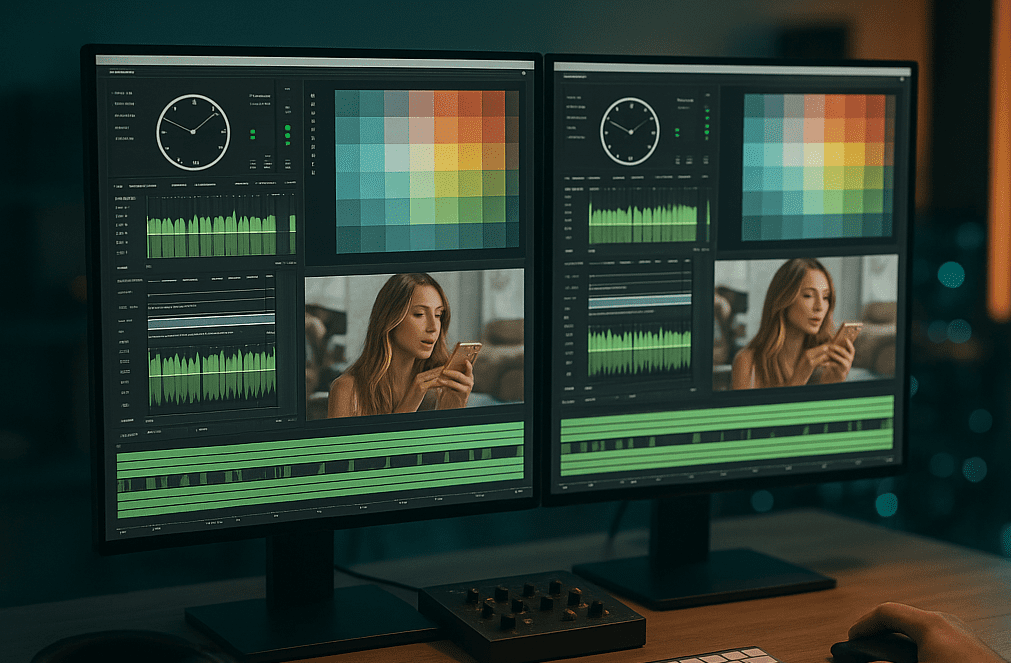Want to Start a Faceless YouTube Channel ASAP?
The idea of making a living from YouTube is exciting, but the thought of being on camera? Not so much. Maybe you’re an introvert, value your privacy, or simply don’t want your face to be the “brand.” If that sounds like you, I have good news: you can build a massively successful YouTube channel without ever showing your face.
So many aspiring creators get stuck on this point, thinking they need a fancy camera and a picture-perfect smile. That’s a myth. A faceless YouTube channel focuses on the value of the content, not the personality on screen. This guide is your no-fluff roadmap. We’ll walk through every practical step, from picking your topic to getting paid, so you can get your channel off the ground.
What is a Faceless YouTube Channel, Really?
First, let’s clear up a common misconception. “Faceless” doesn’t mean “low-effort.” These channels succeed because they deliver high-quality information or entertainment through other means. Think of beautifully animated educational videos, relaxing nature scenes with ambient sounds, or screen-recorded tutorials that solve a specific problem.
The focus shifts from you to the content itself. Your tools are stock footage, screen recordings, animations, a compelling voice-over, and sharp editing. Many creators refer to this model as YouTube automation because it allows for a more systemized approach to content creation, but it still requires a solid strategy.
So many aspiring creators get stuck on this point, thinking they need a fancy camera and a picture-perfect smile. That’s a myth. A faceless YouTube channel focuses on the value of the content, not the personality on screen. This guide is your no-fluff roadmap. We’ll walk through every practical step, from picking your topic to getting paid, so you can get your channel off the ground.
Step 1: Choose a Niche You Can Stick With
Your niche is the foundation of your channel. Choosing the right one makes content creation easier and helps you attract a dedicated audience. Picking a topic you have zero interest in just because it seems profitable is a fast track to burnout.
How to Find Your Perfect Niche
- Follow Your Interests: What could you talk about for hours? What do you find yourself constantly learning about? Your genuine enthusiasm will shine through in your content, even without your face on camera.
- Identify Problems to Solve: People flock to YouTube for answers. Can you teach a skill, explain a complex topic, or provide a “how-to” guide? Niches like software tutorials, personal finance, or cooking are great examples.
- Analyze Profitability: Look for niches with good monetization potential. Are there affiliate products you can promote? Is there high advertiser demand? You can research this using tools like the Google Keyword Planner to see what advertisers are paying for certain keywords.
Popular Faceless Channel Niches:
- Meditation and Relaxation
- Educational Summaries (History, Science, Philosophy)
- Top 10 Lists and Compilations
- Tech Tutorials and App Reviews
- Financial Education and Investing
- Gaming (commentary over gameplay)
- Horror Story Narration
So many aspiring creators get stuck on this point, thinking they need a fancy camera and a picture-perfect smile. That’s a myth. A faceless YouTube channel focuses on the value of the content, not the personality on screen. This guide is your no-fluff roadmap. We’ll walk through every practical step, from picking your topic to getting paid, so you can get your channel off the ground.
Step 2: Master Your Content Research
Once you have a niche, you need a steady stream of video ideas. Your goal is to create content that people are actively searching for. Don’t just guess what your audience wants; use data to find out.
Effective Research Methods
- YouTube Search Bar: Start typing a keyword related to your niche into the YouTube search bar. The autocomplete suggestions are a goldmine of topics that people are currently looking for. For example, if your niche is personal finance, typing “how to invest” will reveal popular searches like “how to invest in stocks for beginners” or “how to invest with little money.”
- Competitor Analysis: Find 5-10 successful channels in your niche. Go to their “Videos” tab and sort by “Most Popular.” This tells you exactly what topics have resonated most with their audience. Don’t copy their videos, but analyze what makes them successful. Is it the title? The thumbnail style? The editing pace?
- Audience Feedback: Once your channel is running, your comments section is an invaluable resource. Pay attention to the questions your viewers are asking. These are direct requests for your next video topic.
So many aspiring creators get stuck on this point, thinking they need a fancy camera and a picture-perfect smile. That’s a myth. A faceless YouTube channel focuses on the value of the content, not the personality on screen. This guide is your no-fluff roadmap. We’ll walk through every practical step, from picking your topic to getting paid, so you can get your channel off the ground.
Step 3: Gather Your Faceless Content Creation Tools
You don’t need a Hollywood budget to create professional-looking videos. A few key tools will handle 90% of the work for you.
Video and Image Resources
For visuals, stock footage is your best friend. It saves you the time and expense of filming your own B-roll.
- Pexels & Pixabay: Both offer huge libraries of high-quality, free-to-use stock photos and videos.
- Envato Elements & Storyblocks: These are subscription-based services with massive, premium-quality libraries. If you plan to produce a lot of content, a subscription is a worthwhile investment for unique footage that helps you stand out.
Screen Recording and Editing Software
This is where you’ll assemble your video. You need software that is both powerful and easy to learn.
- Screen Recording: OBS Studio is a powerful and free tool for screen recording. For Mac users, the built-in QuickTime Player also does a great job.
- Video Editing: DaVinci Resolve offers a free version that is more than capable for professional editing. If you’re looking for something simpler to start, CapCut (desktop and mobile) and Clipchamp (web-based) are excellent, user-friendly options.
So many aspiring creators get stuck on this point, thinking they need a fancy camera and a picture-perfect smile. That’s a myth. A faceless YouTube channel focuses on the value of the content, not the personality on screen. This guide is your no-fluff roadmap. We’ll walk through every practical step, from picking your topic to getting paid, so you can get your channel off the ground.
Step 4: Record and Edit for Engagement
Your voice and editing style are what will keep viewers watching. This is where you inject personality into your faceless channel.
Voice-Over Tips
Your voice is the star of the show. It needs to be clear, confident, and engaging.
- Get a Decent Mic: You don’t need a $500 microphone. A USB mic like the Blue Yeti or Audio-Technica AT2020 provides excellent quality for around $100. It’s the single best investment you can make for your channel’s audio.
- Write a Script: Don’t try to wing it. A script keeps you on track, prevents rambling, and ensures your delivery is smooth. Read it out loud a few times to catch any awkward phrasing.
- Speak with Energy: Smile while you talk, even though no one can see you. It genuinely changes the tone of your voice, making you sound more energetic and approachable.
Editing to Keep Viewers Hooked
The goal of editing is to maintain momentum. You never want your viewer to get bored.
- The 3-Second Rule: Aim to change something on screen every 3-5 seconds. This could be a new video clip, a text overlay, a zoom effect, or a simple transition. This visual variety keeps the brain engaged.
- Use Background Music: A subtle music track can set the mood and fill awkward silences. Use royalty-free music from sources like the YouTube Audio Library or paid services like Epidemic Sound.
- Add Text and Graphics: Use text overlays to emphasize key points. Simple animations or graphics can help explain complex ideas and make your video more visually appealing.
So many aspiring creators get stuck on this point, thinking they need a fancy camera and a picture-perfect smile. That’s a myth. A faceless YouTube channel focuses on the value of the content, not the personality on screen. This guide is your no-fluff roadmap. We’ll walk through every practical step, from picking your topic to getting paid, so you can get your channel off the ground.
Step 5: Stay Consistent and Analyze Your Data
Consistency is more important than perfection. Publishing one video a week is a great starting point for a new channel. This regularity signals to the YouTube algorithm that your channel is active, and it gives your audience something to look forward to.
Use YouTube Studio Analytics to understand what’s working. Pay close attention to two key metrics:
- Click-Through Rate (CTR): This measures how many people clicked on your video after seeing the thumbnail. A low CTR might mean your titles or thumbnails need improvement.
- Audience Retention: This shows you the average percentage of your video that people watch. If you see a big drop-off at a certain point, go back and watch that section. Was it boring? Was the audio bad? Use this data to improve your next video.
So many aspiring creators get stuck on this point, thinking they need a fancy camera and a picture-perfect smile. That’s a myth. A faceless YouTube channel focuses on the value of the content, not the personality on screen. This guide is your no-fluff roadmap. We’ll walk through every practical step, from picking your topic to getting paid, so you can get your channel off the ground.
Step 6: Monetize Your Channel
Finally, let’s talk about making money. The most well-known path is the YouTube Partner Program (YPP), which allows you to run ads on your videos. To qualify, you need 1,000 subscribers and 4,000 hours of public watch time in the last 12 months.
However, there are other, often more lucrative, ways to monetize a faceless YouTube channel:
- Affiliate Marketing: This is perfect for faceless channels. You can recommend products or services in your videos and earn a commission on any sales made through your unique link. For example, a tech tutorial channel can link to the software they are using.
- Selling Digital Products: Create an ebook, a course, or templates related to your niche. This gives you full control over your income.
- Sponsorships: Once you have a dedicated audience, brands may pay you to feature their product in your videos.
Summary
Starting a faceless YouTube channel is an incredible opportunity to share your knowledge and build a business without the pressure of being on camera. It all comes down to a clear strategy.
- Choose a Profitable Niche: Pick something you’re interested in that solves a problem for an audience.
- Research Smart: Use data to find video ideas that people are actively searching for.
- Get the Right Tools: A good mic, stock footage, and user-friendly editing software are all you need.
- Master Your Voice & Editing: Your delivery and pacing are key to keeping viewers engaged.
- Be Consistent & Analyze: Stick to a schedule and use analytics to guide your content strategy.
- Monetize Strategically: Explore affiliate marketing and digital products beyond just ad revenue.
The path is clear. Now it’s time to take the first step.



